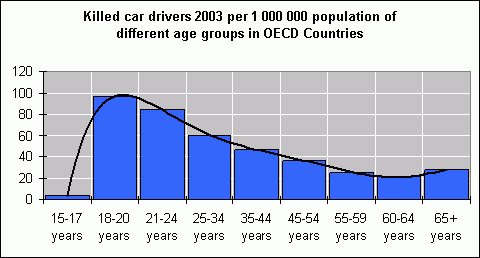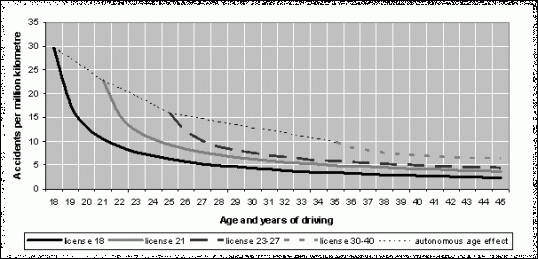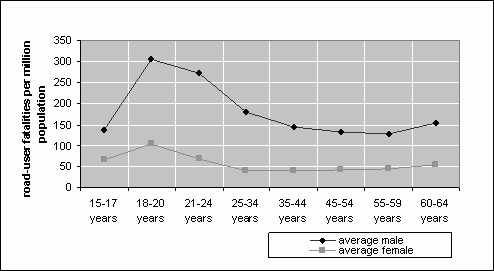Risk
Risk
The concept of risk
Accident frequencies in themselves are not sufficient to draw conclusions about the over-representation of young drivers, as crash frequency is closely related to mileage, the number of licenses per age group, and the population size. Mileage has the strongest link to crashes: the more you drive, the higher the chance that you may get involved in a crash. This is why mileage of those groups needs to be taken into account to enable 'valid' comparisons across driver groups (like age groups or gender). Unfortunately, this type of data is rarely available, and therefore the other 'denominators' like license distribution and population size need to be used. Data on population size are widely available in relatively long time series as well. This is less the case for licensing rates.
Rates by age, experience and gender
Age
Young drivers have a higher fatality rate per head of the population as can be seen in Figure 6. The rate peaks in the age range 18-24, and then gradually declines. This is a feature to be found in most motorized countries.
Figure 6: killed car drivers 2003 per 1.000.000 population of different age groups in OECD countries
Experience
A relevant question that needs answering is whether the fatality rate development is a result of a higher age or a result of increased experience.
Figure 7: Age and driving experience: accident risk controlled for mileage for different age groups of novice drivers (Vlakveld 2004)
Figure 7 presents data from a national survey among car license holders in the Netherlands. The graph shows that the older the driver is when he gets his driving licence, the lower is his initial risk. Consequently, it is safer to gain a licence at a higher age. However, even then it takes many years before the increased risk levels out completely. Similar graphs have been obtained in other countries, and the conclusion is that both young age and lack of experience strongly influence accident risk. It is interesting to know the relative contribution of each factor to this risk. However, from a practical point of view this is less relevant, because in most motorized countries the novices are also young. Thus, both the age related and the inexperience factors need to be dealt with in order to tackle the young driver risk.
Gender
In the age group 18-24, the male young driver's risk is considerably higher than that of the female young driver (Figure 8). National statistics differ in the precise shape of the curve and the absolute difference between the sexes, but the general pattern can be recognized in all countries.
Figure 8: Road user fatalities per million population of different age groups. Source OECD, IRTAD
A possible explanatory factor may be differences in mileage. In other words: young males have more crashes because they simply drive more. The validity of this statement, however, cannot be verified on the basis of international statistics. More detailed national studies show that this pattern still holds good even after correction for the figures for mileage.



